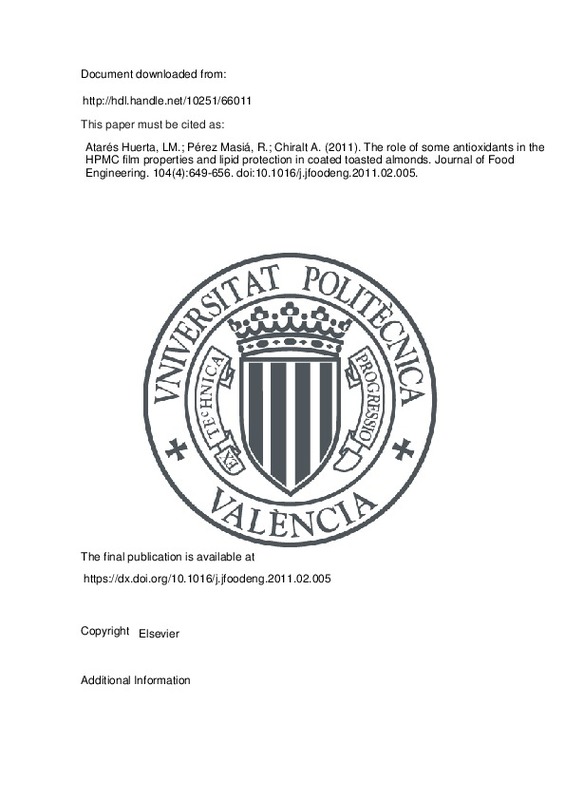Atarés Huerta, LM.; Pérez Masiá, R.; Chiralt, A. (2011). The role of some antioxidants in the HPMC film properties and lipid protection in coated toasted almonds. Journal of Food Engineering. 104(4):649-656. https://doi.org/10.1016/j.jfoodeng.2011.02.005
Por favor, use este identificador para citar o enlazar este ítem: http://hdl.handle.net/10251/66011
|
Título:
|
The role of some antioxidants in the HPMC film properties and lipid protection in coated toasted almonds
|
|
Autor:
|

 Atarés Huerta, Lorena María
Pérez Masiá, Rocío
Atarés Huerta, Lorena María
Pérez Masiá, Rocío

 Chiralt, A.
Chiralt, A.
|
|
Entidad UPV:
|
Universitat Politècnica de València. Departamento de Tecnología de Alimentos - Departament de Tecnologia d'Aliments
|
|
Fecha difusión:
|
|
|
Resumen:
|
[EN] Hydroxypropylmethylcellulose based edible films with and without antioxidant additives were characterised as to their microstructure, water vapour and oxygen permeability, mechanical behaviour, optical properties and ...[+]
[EN] Hydroxypropylmethylcellulose based edible films with and without antioxidant additives were characterised as to their microstructure, water vapour and oxygen permeability, mechanical behaviour, optical properties and protective ability against lipid oxidation. The corresponding film-forming dispersions were also used to coat toasted almonds in order to test their effectiveness at protecting against rancidity development. The efficiency of three additives (ascorbic acid, citric acid or ginger essential oil) was tested and compared with antioxidant-free coatings. A cross-linking effect in the film matrices containing ascorbic or citric acid was detected through the analysis of the film microstructure, mechanical behaviour and barrier properties to oxygen and water vapour. These films were the most effective protectors against oxidation of almonds, due to both their antioxidant effect and the tighter structure which leads to lower oxygen permeability. In films with ginger oil, the hydrophobic effect markedly reduced water vapour permeability at low temperatures, but protection against lipid oxidation was less effective at long storage times. © 2011 Elsevier Ltd. All rights reserved.
[-]
|
|
Palabras clave:
|
Almond
,
Ascorbic acid
,
Citric acid
,
Edible coatings
,
Ginger oil
,
Hydroxypropylmethylcellulose
,
Edible coating
,
Hydroxypropyl methylcellulose
,
Coatings
,
Essential oils
,
Food additives
,
Hydrophobicity
,
Ketones
,
Mechanical engineering
,
Mechanical properties
,
Microstructure
,
Optical properties
,
Organic acids
,
Oxidation
,
Oxygen
,
Oxygen permeable membranes
,
Mechanical permeability
,
Prunus dulcis
,
Zingiber officinale
,
Electron Microscopy Service of the UPV
|
|
Derechos de uso:
|
Reserva de todos los derechos
|
|
Fuente:
|
Journal of Food Engineering. (issn:
0260-8774
)
|
|
DOI:
|
10.1016/j.jfoodeng.2011.02.005
|
|
Editorial:
|
Elsevier
|
|
Versión del editor:
|
https://dx.doi.org/10.1016/j.jfoodeng.2011.02.005
|
|
Código del Proyecto:
|
info:eu-repo/grantAgreement/MEC//AGL2007-65503/ES/DESARROLLO DE RECUBRIMIENTOS COMESTIBLES CON MEZCLAS POLISACÁRIDO-PROTEÍNA-LÍPIDO. ANÁLISIS DE LA INFLUENCIA DE LAS PROPIEDADES DE LA EMULSIÓN EN LA FUNCIONALIDAD DEL FILM/
info:eu-repo/grantAgreement/UPV//PAID-06-08-3242/
|
|
Agradecimientos:
|
The authors acknowledge the financial support from the Spanish Ministerio de Educacion y Ciencia through Project AGL2007-65503/ALI and from the Universidad Politecnica through Project PAID-06-08-3242. Authors also thank ...[+]
The authors acknowledge the financial support from the Spanish Ministerio de Educacion y Ciencia through Project AGL2007-65503/ALI and from the Universidad Politecnica through Project PAID-06-08-3242. Authors also thank Manuel Planelles, Jose Luis Mova and Mercedes Tabernero from UPV Electronic Microscopy Service for their kind assistance in the use of SEM.
[-]
|
|
Tipo:
|
Artículo
|







![[Cerrado]](/themes/UPV/images/candado.png)


